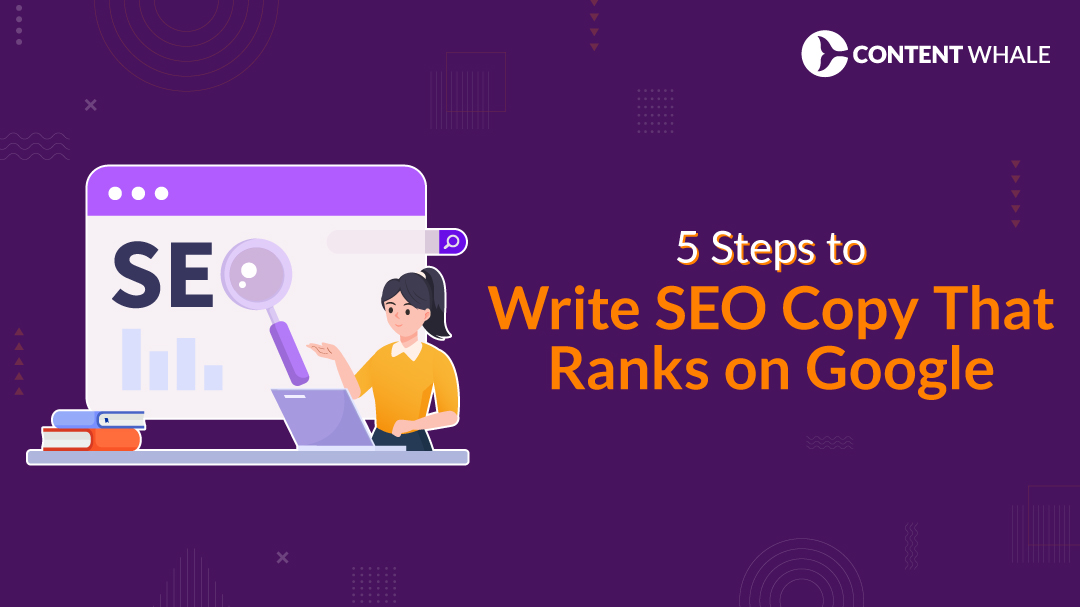Writing a compelling copy for SEO isn’t just about sounding creative—it’s about making sure your content reaches the right audience by working with Google’s search rankings. As search engines evolve, mastering the right content writing strategies can help your copy gain visibility and drive organic traffic. It starts with understanding how keyword optimization works and ensuring your copy is not only engaging but also optimized for on-page SEO.
In this guide, we’ll cover the essentials of SEO copywriting tips that will teach you how to create content that ranks. From performing thorough keyword research to enhancing your user experience, these steps will help you improve your website’s SEO content creation and ensure your copy stands out. By focusing on these proven techniques, you can build high-quality, search engine visibility that delivers long-term results.
1. Start with Thorough Keyword Research
The foundation of writing compelling copy for SEO begins with comprehensive keyword research. Identifying the right keywords sets the stage for how well your content will perform in Google search rankings and attract organic traffic. Here’s how you can do it effectively:
A) Use Effective Keyword Research Tools
To find the most relevant keywords, rely on keyword research tools like SEMrush, Ahrefs, and Google Keyword Planner. These tools help you discover high-volume, low-competition keywords that are easier to rank for. Additionally, focusing on long-tail keywords—phrases with three or more words—will often result in better targeting and less competition.
- Tip: Prioritize keywords that match your audience’s intent and align with your SEO content creation goals.
B) Understand Search Intent
One of the key elements of SEO copywriting tips is to understand the search engine algorithms that interpret user intent. Whether the intent is informational, navigational, or transactional, aligning your content with these goals ensures your copy addresses what users are truly looking for. This not only increases engagement but also improves search engine visibility.
- Example: A user searching for “how to choose a laptop” is likely looking for informational content, so your copy should be tailored to offer detailed advice and high-quality content.
C) Optimize for On-Page SEO
Once you’ve chosen your keywords, it’s time to strategically place them throughout your content for on-page SEO optimization. This includes:
- Using keywords in H1 tags and header tags (H2, H3) for a clear content hierarchy.
- Including the primary keyword within the first 100 words of your content.
- Crafting meta descriptions with keywords that accurately describe the content and attract clicks.
These practices help signal to Google’s algorithm that your content is relevant, increasing the chances of higher rankings.
D) Analyze Your Competitors
Take a look at what your competitors are ranking for. Using keyword research tools, you can identify keyword gaps in their content and find opportunities to rank for terms they may be overlooking. Analyzing competitors also allows you to see what’s working and gives you inspiration to create content that surpasses theirs.
- Tip: Look for content that isn’t optimized for mobile-friendly content, and leverage that gap by ensuring your content is responsive across all devices.
2. Craft Engaging and Keyword-Rich Titles

The title of your content is the first thing both search engines and users will see, making it a critical component of writing compelling copy for SEO. A well-crafted title can significantly boost your content’s click-through rate (CTR) and improve its position in Google search rankings. Here’s how to create titles that work:
A) Include Your Primary Keyword Early
For SEO best practices, it’s important to place your primary keyword at the beginning of your title whenever possible. This not only signals relevance to Google but also grabs the reader’s attention immediately. For example, if your target keyword is “SEO copywriting tips,” a strong title could be: “SEO Copywriting Tips: How to Rank Higher on Google.”
- Tip: Keep your titles concise, ideally under 60 characters, to ensure they display fully in search engine results.
B) Use Power Words for Engagement
Along with keyword optimization, adding power words to your title can make it more compelling and clickable. Words like “proven,” “ultimate,” or “step-by-step” can improve your CTR, which is a key factor for Google’s algorithm in determining how well your content will perform.
- Example: “5 Proven SEO Copywriting Tips to Boost Your Rankings.”
C) Structure Titles for Readability and SEO
It’s essential to balance the needs of both search engines and readers when crafting titles. Make sure your title flows naturally while incorporating relevant keywords. Using H1 tags to define your title helps with both on-page SEO and readability. Additionally, using numerals (like “5 tips” or “10 steps”) in your title can make it more scannable and appealing to readers.
- Pro Tip: Analyze high-ranking content in your niche to see which types of titles are driving the most engagement and adapt your approach accordingly.
3. Structure Your Content for Readability and SEO
A well-structured piece of content not only enhances user experience but also plays a crucial role in improving on-page SEO. How you organize your copy affects how search engine algorithms crawl and understand your content, which directly impacts its ranking on Google search rankings. Here’s how to structure your content for both readability and SEO.
A) Use Headings and Subheadings Effectively
Break your content into sections using clear, descriptive headings. Using H1 tags for your main title and H2, H3 tags for subheadings creates a logical flow that’s easy to follow. Search engines prioritize content that’s properly structured, so integrating your primary keyword and related terms into these tags will improve your content’s relevance for specific search queries.
- Tip: Ensure your headings are concise and keyword-focused, making them easy to scan for readers and search engines alike.
B) Break Up Large Blocks of Text
Readers are more likely to engage with content that is easy to digest. Large blocks of text can overwhelm users, leading to a high bounce rate—something Google’s algorithm penalizes. Keep paragraphs short and break them up with bullet points, numbered lists, or images where appropriate. This will improve user experience and signal to Google that your content is reader-friendly.
- Example: A list of SEO copywriting tips could be displayed as bullet points, making it easier for readers to absorb information quickly.
C) Include Internal Linking
Internal links help guide users to other relevant pages on your website, improving site navigation and increasing dwell time—both of which are positive SEO signals. Additionally, internal linking helps distribute page authority across your site, which can improve rankings for other pages. Make sure to link relevant high-quality content from within your site that complements the topic you’re covering.
- Pro Tip: Use keyword-rich anchor text in your internal links to further boost SEO content creation efforts and ensure each link adds value to the reader.
D) Optimize for Mobile and Visual Appeal
With more users accessing content from mobile devices, it’s critical that your content is optimized for a mobile-friendly experience. Ensure the text adjusts properly on smaller screens, images load quickly, and buttons or links are easy to click. Google has prioritized mobile-friendly content, making this an important part of any SEO best practices strategy.
4. Optimize On-Page Elements

Optimizing on-page elements is a crucial step in writing compelling copy for SEO. These components tell search engines what your content is about, helping improve its visibility in Google search rankings. Here are the key elements to focus on:
A) Place Keywords Strategically
Keywords play a vital role in on-page SEO. For the best results:
- Include your primary keyword in the first 100 words of your content.
- Use keywords naturally in H1 tags, header tags (H2, H3), and throughout the body of the text.
- Avoid overusing keywords (known as keyword stuffing) to prevent penalties from Google’s algorithm.
By placing keywords strategically, you create a balance between SEO best practices and readability.
B) Optimize Meta Tags and Descriptions
Your meta descriptions and meta tags are often the first things users see in search engine results. They need to be informative and engaging while also including keywords.
- Keep your meta descriptions concise, ideally under 160 characters.
- Ensure your primary keyword is present in both the meta title and description.
- Use secondary keywords where they naturally fit to enhance search engine visibility.
This not only boosts your SEO content creation but also improves click-through rates, making your content more competitive.
C) Improve Image SEO with Alt Text
Images make your content more engaging, but optimizing them for SEO is essential.
- Use descriptive alt text for all images, incorporating relevant keywords where appropriate.
- Optimize file sizes to reduce page load times, improving user experience and enhancing Google rankings.
Alt text optimization can also help your images appear in Google Image search, providing another source of organic traffic.
D) Use Internal Links
Internal linking guides users to other relevant pages on your website and distributes page authority across your site.
- Include 2-3 internal links to related content.
- Use keyword-rich anchor text for these links to improve on-page SEO and help users discover additional high-quality content.
| # | On-Page Element | Best Practice | Example |
| 1 | Primary Keyword | Use in the first 100 words, headers, and naturally in text. | “Writing compelling copy for SEO” in H1. |
| 2 | Meta Description | Keep under 160 characters and include primary keyword. | “Learn 5 steps to rank better with SEO.” |
| 3 | Alt Text | Include relevant keywords; keep it descriptive but concise. | “Image showing SEO keyword research tool.” |
| 4 | Internal Links | Link to other relevant, high-quality content on your site. | Anchor text: “on-page SEO guide.” |
| 5 | Header Tags | Use H1, H2, and H3 tags to organize content structure. | H1: “Writing Compelling Copy for SEO” |
| 6 | URL Structure | Keep URLs short, descriptive, and include primary keyword. | /write-compelling-seo-copy |
5. Focus on User Experience and Mobile Optimization
Creating compelling copy for SEO isn’t just about keywords and meta tags—it’s about offering a seamless user experience. Google prioritizes websites that provide a positive experience to users, and this plays a significant role in your Google search rankings. Optimizing your content for user engagement, accessibility, and mobile devices is essential for boosting your SEO performance. Here’s how to do it effectively:
A) Improve Page Load Speed
A fast-loading page is crucial for user experience and directly impacts how your site ranks in Google’s algorithm. Slow pages lead to high bounce rates, which can harm your SEO efforts.
- Tip: Compress images, reduce redirects, and leverage browser caching to improve loading times.
- Use Google’s PageSpeed Insights to regularly check your site’s speed and optimize accordingly.
B) Ensure Mobile-Friendly Content
With the majority of users accessing content through mobile devices, having mobile-friendly content is no longer optional—it’s essential for ranking well. Google’s mobile-first indexing means the search engine primarily evaluates your mobile site, so your content must be responsive and easy to navigate on smaller screens.
- Use responsive design to ensure your content adjusts to any screen size.
- Keep paragraphs short and use header tags to organize content for easy navigation.
- Ensure that images and videos are optimized to load quickly on mobile devices.
C) Enhance User Engagement
The more time users spend on your page, the better it signals to Google that your content is valuable. To boost user engagement:
- Use bullet points, numbered lists, and short paragraphs to make the content scannable.
- Incorporate visuals like images and infographics to break up text and maintain reader interest.
- Add internal links to keep users exploring other pages on your site, which can reduce bounce rates and improve dwell time.
D) Prioritize Readability
Readability is key to keeping your audience engaged. Content that is difficult to read can push users away, affecting your rankings. Use easy-to-understand language, avoid jargon, and break up text into digestible sections using on-page SEO techniques like subheadings and lists.
- Tip: Tools like Hemingway and Grammarly can help ensure your content is clear and easy to read.
Conclusion

Creating compelling copy for SEO requires a blend of creativity and strategy. By focusing on thorough keyword research, crafting engaging and keyword-rich titles, structuring your content for both on-page SEO and readability, optimizing all on-page elements, and enhancing the overall user experience, you set the stage for content that performs well in Google search rankings.
Remember, the key is to balance SEO best practices with quality writing that speaks to your audience. Stay consistent in optimizing your content, stay updated with search engine algorithms, and always prioritize the user. These steps not only help your content rank but also ensure it brings in valuable organic traffic. In a competitive digital space, these strategies will keep your website relevant and visible over time.
At Content Whale, we specialize in SEO content creation that drives results. With years of experience, we craft high-quality content optimized for search engines, ensuring improved search engine visibility and increased organic traffic. Our expert team understands the nuances of on-page SEO, keyword optimization, and user engagement to help your content rank higher.
Let us help you to create content that not only resonates with your audience but also ranks well on search engines. Contact us today to elevate your SEO strategy and watch your website performance soar!
FAQs
1. What is SEO copywriting?
SEO copywriting is the practice of writing content that is both engaging for readers and optimized for search engines. This involves using keywords, structuring content with on-page SEO techniques, and focusing on elements like meta descriptions, headers, and internal linking to improve search engine visibility and increase organic traffic.
2. How can I improve my Google ranking with copywriting?
To improve your Google search rankings, focus on keyword optimization, creating high-quality content, and following SEO best practices. Use H1 tags and header tags to organize your content, include relevant keywords naturally, and ensure your site provides a great user experience. Don’t forget to optimize for mobile and use internal links to guide readers to related pages.
3. Why is keyword research important in SEO copywriting?
Keyword research is crucial because it helps you understand what your target audience is searching for and how you can position your content to match those queries. Using keyword research tools helps identify the right terms to incorporate into your copy, making it easier for your content to rank on Google and attract organic traffic.
4. How do meta descriptions impact SEO?
Meta descriptions provide a brief summary of your content in search engine results. A well-optimized meta description includes your primary keyword and can significantly increase your click-through rate, which impacts your rankings. Keep them concise, engaging, and informative to encourage more users to click on your page.
5. How do I optimize my content for mobile users?
To ensure your content is mobile-friendly, use responsive design, shorter paragraphs, and header tags to improve readability on small screens. Additionally, optimize images for faster load times and ensure your website functions seamlessly across different devices.





